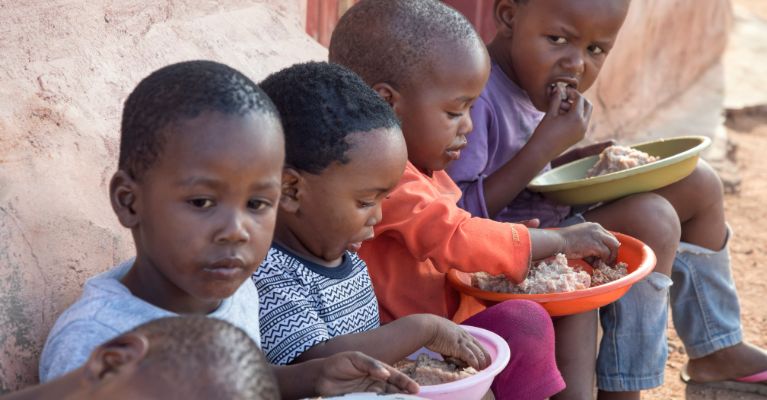Devastating oro-facial gangrene disease is designated Neglected Tropical Disease status
Type of article: News | Long Form
MedED Catalogue Reference: MGN009
Category: News | Public Health, tropical diseases,
Keywords: tropical diseases, malnutrition, paediatrics, public health
Top

18 December 2023, 09:11
Contributor: Linda Ravenhill
Noma (Cancrum oris), a devastating oro-facial gangrene that affects mainly children, has been added to the list of neglected tropical diseases. The inclusion was announced last week at the 17th meeting of the Strategic and Technical Advisory Group for Neglected Tropical Diseases (STAG-NTD). The inclusion heralds a turning point for one of the world’s most under-recognised health challenges.
NTDs are a diverse group of conditions prevalent in tropical and subtropical areas. They principally occur in impoverished communities and have a disproportionate effect on women and children. NTDs are complex diseases, often related to environmental conditions, making their control challenging. The health, social and economic consequences of these conditions are devastating, with more than one billion people said to be affected by one or more NTD. Noma is the twenty-first condition to have been listed.5
Noma Case Study
1.Weledji, E. P., & Njong, S. (2016). Cancrum Oris (Noma): The Role of Nutrition in Management. The journal of the American College of Clinical Wound Specialists, 7(1-3), 50–52. https://doi.org/10.1016/j.jccw.2016.08.003
The Government of Nigeria spearheaded the initiative to include noma on the list. Although sub-Saharan Africa bears the most significant disease burden, Nigeria also faces a substantial impact, with the Nigerian Centre for Disease Control reporting 37,646 noma cases between 2011 and 2017.3 However, it is believed that the actual number may be much higher. This challenge in determining the actual incidence is reflected in the global data: while conservative estimates suggest an annual infection rate of 30,000–40,000 patients, while some estimates suggest the actual number could be closer to 140,000 cases per year. 1,2,4
Children between 2 and 6 years of age are most affected, most of whom live in sub-Saharan Africa. In these communities, malnourishment is prevalent, and many of the children are immuno-compromised, resulting from diseases such as measles, malaria, and TB. Mortality rates are high: according to a 2017 overview published in the American Journal of Tropical Medicine and Hygiene, 85% of those who have the condition do not survive. Those who do survive are often severely disfigured and have problems with eating and swallowing, leaving them vulnerable to other diseases. Furthermore, the economic and social burden is crippling to affected individuals and their communities: the authors of the previously mentioned article calculated the disease burden as a loss of 1–10 million disability-adjusted life years.2
Noma is not contagious. It is an opportunistic infection caused by the spirochete Borrelia vincenti, which typically occurs in conjunction with an anaerobic bacterium, most often one of the Fusobacterium species.
Therapeutic interventions include antibiotics, oral hygiene measures and a commensurate improvement in nutritional status. For those who survive the gangrenous stage of the disease, complex surgical rehabilitation is frequently required to repair facial disfigurement and resolve other issues that may have arisen. These interventions depend on a reasonably sophisticated healthcare system, which is absent in most poverty-stricken communities.
Therefore, early detection and prevention are critical to reducing the burden of the disease. For this reason, the addition of noma to the NTD list will be a game changer.
The designation will help raise awareness of the condition and mobilise the finances to fund the multisectoral and multi-pronged approaches necessary to control the disease. Measures such as increasing measles vaccination in affected communities, preventing illnesses such as malaria and HIV, and improving access to food programs will help reduce the burden of noma and enhance the community's overall well-being to prevent other conditions from arising. Furthermore, the NTD designation will catalyse research efforts to improve treatments and outcomes, which are vital in alleviating and possibly eradicating the condition.
Announcing the designation at a press conference on Wednesday, WHO Director-General Dr Tedros Adhanom Ghebreyesus stated:
"Noma is more than a disease, it is a social marker of extreme poverty and malnutrition, affecting the most vulnerable populations. ……By classifying noma as a neglected tropical disease, we are shining a light on a condition that has afflicted marginalized communities for centuries. We are committed to working with affected countries and communities to address the drivers of noma, and alleviate the suffering it causes.”
Access associated content
2.Srour, M. L., Marck, K., & Baratti-Mayer, D. (2017). Noma: Overview of a Neglected Disease and Human Rights Violation. The American journal of tropical medicine and hygiene, 96(2), 268–274. https://doi.org/10.4269/ajtmh.16-0718
3.Farley E, Oyemakinde MJ, Schuurmans J, et alThe prevalence of noma in northwest Nigeria BMJ Global Health 2020;5:e002141
WHO Fact Sheet
4. Noma Fact Sheet
Neglected Tropical Diseases List
5.WHO NTD List (PDF)
Back to top
This article is compiled from various resources researched and compiled by the contributor. It is in no way presented as an original work. Every effort has been made to correctly attribute quotes and content. Where possible, all information has been independently verified. The Medical Education Network bears no responsibility for any inaccuracies which may occur from the use of third-party sources. If you have any queries regarding this article contact us
Fact-checking Policy
The Medical Education Network makes every effort to review and fact-check the articles used as source material in our summaries and original material. We have strict guidelines in relation to the publications we use as our source data, favouring peer-reviewed research wherever possible. Every effort is made to ensure that the information contained here is an accurate reflection of the original material. Should you find inaccuracies, out of date content or have any additional issues with our articles, please make use of the contact us form to notify us.


